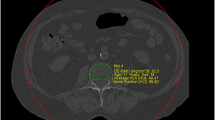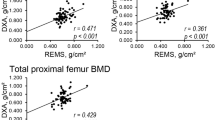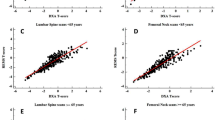Abstract
The bone mineral density (BMD) of lumbar vertebrae in the anteroposterior (AP) view may be overestimated in osteoarthritis or with aortic calcification, which are common in elderly. Furthermore, the risk of spinal crush fracture should be more closely related inversely to the BMD of the vertebral body than to that of the posterior arch. Therefore, we measured BMD of lumbar vertebrae in lateral (LAT) view (L2–L3), using a standard dual-energy X-ray absorptiometer (DEXA), thus eliminating most of the posterior spinal elements. The precision of BMD LAT measurement was determined both in vitro and in healthy volunteers. Then, we compared the capability of BMD LAT and BMD AP scans for monitoring bone loss related to age and for discriminating the BMD of postmenopausal women with nontraumatic vertebral fractures from that of young subjects. In vitro, when a spine phantom was placed in lateral position in the middle of 26 cm of water in order to simulate both soft-tissue thickness and X-ray source remoteness, the coefficient of variation (CV) of six repeated determinations of BMD was 1.0%. In vivo, the CV of paired BMD LAT measurements obtained in 20 healthy volunteers after repositioning was 2.8%. The age-related difference between a peak bone mass group estimated in a group of 27 healthy women aged 20 to 35 years and a group of 50 women aged 60 to 75 years, in whom neither vertebral fracture nor osteoporosis risk factors could be detected, were 21.7% and 37.6% in AP and LAT view, respectively. An arbitrary BMD fracture threshold was defined in AP and LAT views as the 90th percentile of the BMD value of a group of 22 osteoporotic women with vertebral fractures. The distribution of BMD AP and LAT above and below this threshold in 169 consecutively screened women without vertebral fracture was then analysed. In both AP and LAT views, 39.1% and 31.3% had BMD values above and below this threshold, respectively. Of the remaining, 16.0% had a BMD below this threshold only in AP and 13.6% only in LAT view. Thus, if BMD LAT was a better reflection of vertebral body bone mass than BMD AP, and thereby a better predictor of the resistance to crush fracture, our results would suggest that only the use of the standard AP view could under- or overestimate spinal fracture risk in about 30% of women screened for osteoporosis. In conclusion, our results indicate that BMD measurement in lateral view is feasible with a standard DEXA instrument. This mode of scanning, besides overcoming artefacts due to osteoarthritis of the posterior arch and aortic calcifications, appears to provide a greater sensitivity for assessing bone mass loss of the vertebral body than the standard anteroposterior scan.
Similar content being viewed by others
References
Genant HK, Block JE, Steiger P, Glueer, Smith R. Quantitative computed tomography in assessment of osteoporosis. Semin Nucl Med 1987; 4: 316–33.
Uebelhart D, Duboeuf F, Meunier P, Delmas P. Vertebral bone mineral density (BMD) measurement assessed by lateral dual-photon absorptiometry (DPA). J Bone Min Res 1990; 5: 525–31.
Pacifici R, Rupich R, Vered I et al. Dual energy radiography (DER): a preliminary comparative study. Calcif Tissue Int 1988; 43: 189–91.
Mazess R, Collick B, Trempe J, Barden H, Hanson J. Performance evaluation of a dual-energy X-ray bone densitometer. Calcif Tissue Int 1988; 44: 228–32.
Kelly TL, Slovick DM, Schoenfeld DA, Neer RM. Quantitative digital radiography versus dual photon absorptiometry of the lumbar spine. J Clin Endocrinol Metab 1988; 67: 839–44.
Wahner HW, Dunn WL, Brown ML, Morin RL, Riggs BL. Comparison of dual-energy X-ray absorptiometry and dual photon absorptiometry for bone mineral measurements of the lumbar spine. Mayo Clin Proc 1988; 63: 1075–84.
Braillon P, Duboeuf F, Meary MF, Barret P, Delmas PD, Meunier PJ. Mesure du contenu minéral osseux par radiographie digitale quantitative. Presse Med 1989; 18: 1062–5.
Slosman DO, Rizzoli R, Donath A, Bonjour J-Ph. Quantitative digital radiography and conventional dual-photon bone densitometry: study of precision at the levels of spine, femoral neck and femoral shaft. Eur J Nucl Med in press.
Fogelman I. An evaluation of the contribution of bone mass measurements to clinical practice. Semin Nucl Med 1989; 19: 62–8.
Johnston Jr CC, Melton III LJ, Lindsay R, Eddy DM. Clinical indications for bone mass measurements. J Bone Min Res 1989; 4(Suppl 2): 1–28.
Lindsay R, Fey C, Haboubi A. Dual-photon absorptiometric measurements of bone mineral density increase with source life. Calcif Tissue Int 1987; 41: 293–4.
Dawson-Hughes B, Deehr MS, Berger PS, Dallal GE, Sadowski LJ. Correction of the effects of source, source, source strength, and soft-tissue thickness on spine dual-photon absorptiometry measurements. Calcif Tissue Int 1989; 44: 251–7.
Nilas L, Gotfredsen A, Riis BJ, Christiansen C. The diagnostic validity of local and total bone mineral measurements in postmenopausal osteoporosis and osteoarthritis. Clin Endocrinol 1986; 25: 711–20.
Cummings SR, Kelsey JL, Nevitt MC, O'Dowd KJ. Epidemiology of osteoporosis and osteoporotic fractures. Epidemiol Rev 1985; 7: 178–208.
Melton LJ III, Kan SH, Frye MA, Wahner HW, O'Fallon WM, Riggs BL. Epidemiology of vertebral fractures in women. Am J Epidemiology 1989; 129: 1000–11.
Uebelhart D, Braillon P, Meunier PJ, Delmas PD. Lateral-dual-photon absorptiometry of the spine in vertebral osteoporosis and osteoarthritis comparison with quantitative computed tomography. J Bone Min Res 1989; 4(Suppl 1): S328.
Raymakers JA, Hoekstra O, van Putten J. Osteoporotic fracture prevalence and bone mineral mass measured with CT and DPA. Skeletal Radiol 1986; 15: 191–7.
Author information
Authors and Affiliations
Rights and permissions
About this article
Cite this article
Slosman, D.O., Rizzoli, R., Donath, A. et al. Vertebral bone mineral density measured laterally by dual-energy X-ray absorptiometry. Osteoporosis Int 1, 23–29 (1990). https://doi.org/10.1007/BF01880412
Issue Date:
DOI: https://doi.org/10.1007/BF01880412




